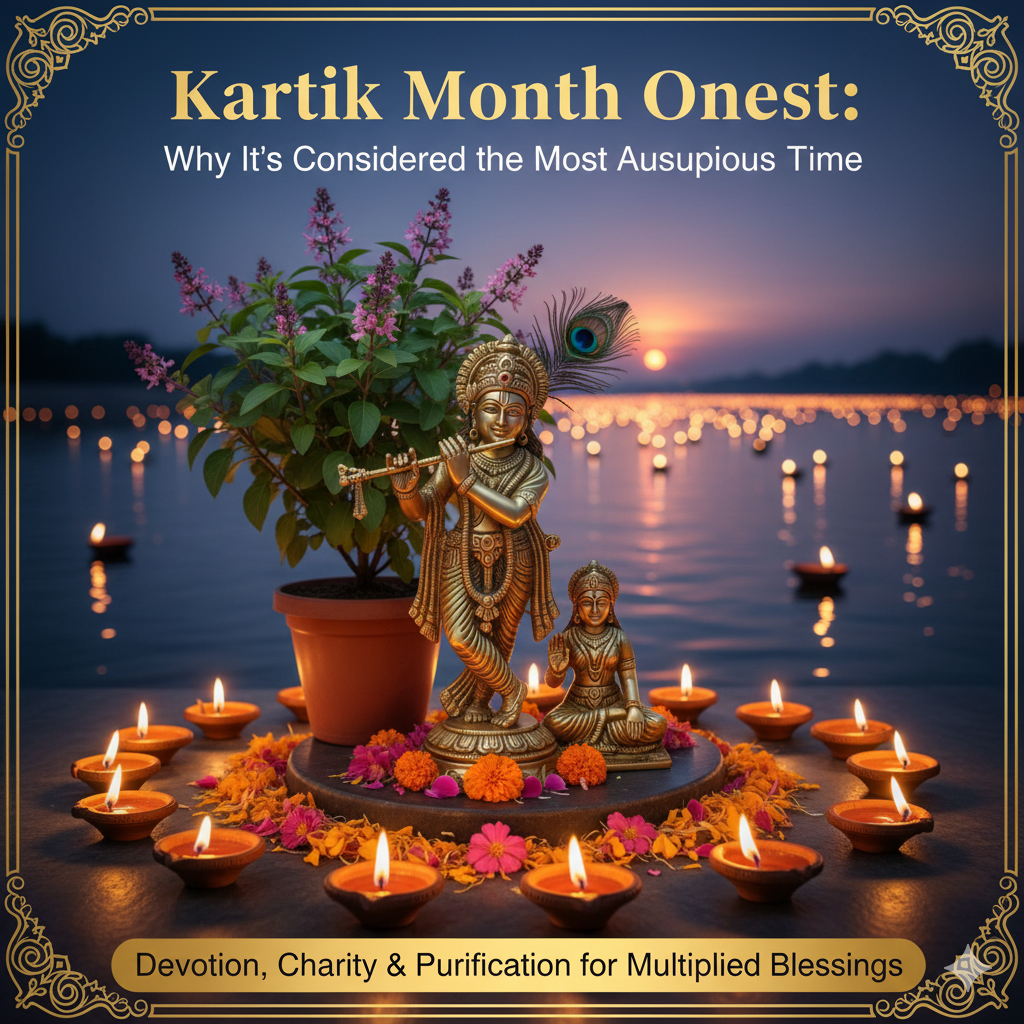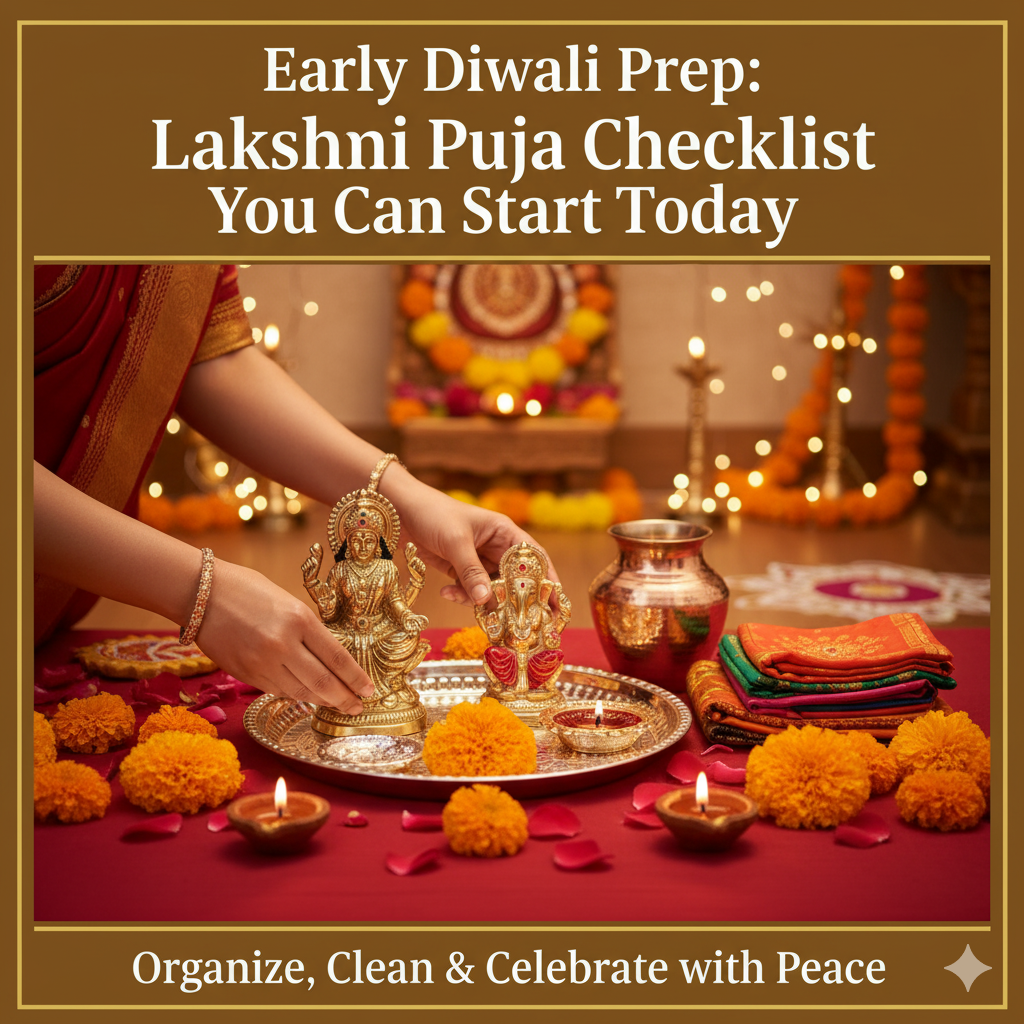
अक्तूबर 04, 2025
How to Consecrate a Fresh Altar After Navratri
After nine sacred nights of Navratri filled with prayers, mantras, and divine vibrations, your home altar becomes a powerful spiritual space. But as the festival ends, it’s essential to consecrate the altar again — to restore purity, invite renewed energy, and prepare it for Kartik and Diwali rituals ahead. Just as temples undergo punar-pratishtha (re-consecration), your home mandir too benefits from a gentle reset. This isn’t about rebuilding your altar — it’s about cleansing, re-energizing, and sanctifying it so the divine presence continues to bless your home. Why Consecrating the Altar After Navratri Matters 1. Restores Spiritual Balance During Navratri, your mandir absorbs intense energy from continuous chanting, incense, and offerings. Re-consecration balances this energy and removes any heaviness. 2. Invites Lakshmi & Vishnu Energies for Kartik Kartik month (which follows Navratri) is dedicated to Vishnu and Lakshmi. A refreshed altar attracts their divine grace during Deepdan and Tulsi Vivah rituals. 3. Keeps the Mandir Sattvic Just like we clean our homes physically, the altar needs energetic cleansing to stay sattvic — pure, fragrant, and spiritually active. Step-by-Step Guide: How to Consecrate a Fresh Altar Step 1: Prepare the Space Choose a quiet morning or an auspicious tithi (like Ekadashi or Purnima). Open windows and allow sunlight to enter — natural light energizes the space. Play soft bhajans or mantras while you begin. Step 2: Cleanse the Altar Physical Cleaning Remove all idols, photos, thalis, and lamps carefully. Dust and wipe the mandir with a clean cloth soaked in ganga jal, rose water, or sandalwood water. Replace altar cloths with fresh silk or cotton fabrics. Energetic Cleansing Light camphor or dhoop and move it clockwise in all directions. Ring a bell (ghanti) or blow a conch (shankh) — the vibrations purify the space. ✨ Tip: You can use loban or guggul dhoop for deeper energetic cleansing. Step 3: Cleanse the Deities (Murti or Photo) Gently clean idols with a mix of water, milk, and a pinch of turmeric. Wipe dry with a soft cloth. Apply a tilak of sandalwood or kumkum. For silver or brass idols, use tamarind water to remove stains (see your Brass & Silver Care Guide). 📖 Scriptural reference: The act of washing and adorning idols (snan and alankara) is considered an offering of love — it renews the connection between devotee and deity. Step 4: Rearrange with Intention When placing the items back: Keep idols facing east or west for proper energy flow. Arrange lamps (deepas) in front, incense at side, and flowers below. Place Tulsi leaf, betel nut, or fresh flower near the deity. If you have limited space, even a small, clean corner with one diya and idol is equally auspicious. Step 5: Perform a Simple Consecration Puja Items Needed: Ganga jal or rose water Flowers Kumkum, haldi Rice, diya, and incense Panchamrit (milk, curd, honey, sugar, ghee) Steps: Light a diya and incense. Sprinkle ganga jal on the altar and around your home. Offer flowers to each deity while chanting: “Om Shree Gurubhyo Namah”“Om Namo Bhagavate Vasudevaya” Offer panchamrit to the idols and wash with clean water. Perform a brief aarti with a ghee diya. Offer prasadam — fruits or sweets — as your first post-Navratri offering. Step 6: Set Your Sankalp (Intention) Before concluding, place your hands in prayer and say your sankalp for the new cycle — prosperity, harmony, health, or spiritual growth.You can even write this intention on a small piece of paper and place it under your Lakshmi idol or kalash. Additions to Make Your Altar Special This Month Tulsi Plant: Essential for Kartik rituals and Deepdan. Brass Deepdan Diya: Keep one dedicated for the Kartik month lamp lighting. Lakshmi Charan Paduka: Place near the entrance of the altar to invite abundance. Crystal or Rudraksha Mala: Enhances positive energy. 👉 Shop these and more in Prasadam Kits & Puja Essentials for easy at-home setup. Dos and Don’ts for Altar Consecration ✅ Do: Keep the altar clean daily with a light dusting. Replace flowers and water every morning. Use only sattvic fragrances (sandal, jasmine, rose). Keep prasadam covered and fresh. ❌ Don’t: Keep damaged idols or broken diyas. Store personal items in the mandir area. Perform puja with unclean hands or clutter nearby. Daily Maintenance for a Consecrated Altar Morning: Light one diya and chant your daily mantra. Evening: Offer a tulsi leaf and light a ghee diya during Kartik month. Weekly: Wipe idols, replace flowers, and refresh the water bowl. 📿 Tip: Even 5 minutes of daily devotion keeps the altar’s aura active. FAQs Q1. When should I re-consecrate my altar?After major festivals like Navratri, Diwali, or once every few months for energetic renewal. Q2. Can I perform consecration without a pandit?Yes. A sincere heart and devotion matter more than ritual perfection. Q3. What to do with old altar cloths or broken items?Donate clean ones; immerse or bury broken items respectfully. Q4. Can the altar be in a bedroom or living room?Yes, if it’s kept clean and not facing the bed directly. Conclusion Consecrating your altar after Navratri is an act of gratitude — you’re thanking the Goddess for her presence and inviting new divine energy for Kartik and Diwali. When you cleanse, reorganize, and rededicate your space, you align your home’s vibration with peace and abundance. ✨ Begin your altar renewal today: Order Prasadam Kits & Puja Essentials for pure items. Or Book a Puja or Chadhawa to have expert pandits bless your home altar remotely. A refreshed altar is not just a place of worship — it’s the heart of your home, glowing with devotion and divine energy. 🌸










